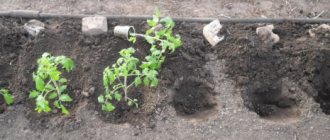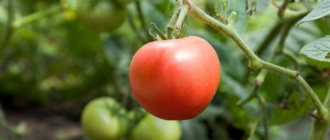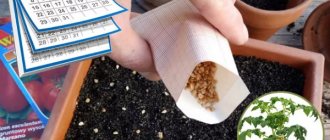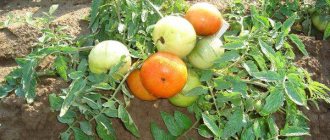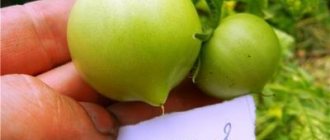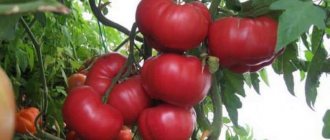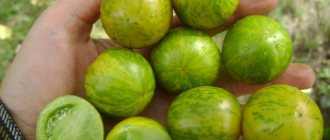Characteristics and description of the variety
The hybrid variety Katyusha was first heard of in 2001, when it was included in the State Register of Cultivated Plants as a variety recommended for planting in open and closed soil. Since that time, many gardeners have become convinced of its merits, which is why the large-fruited hybrid tomato Katyusha is increasingly found on plots. At the stage of full maturity, the fruits weigh at least 120 g each. All of them are characterized by pink or hot pink color and round shape. Inside there are 6–8 chambers with seeds, in which about 5% of their composition is dry matter.
Did you know? Tomato pulp contains a large amount of the so-called happiness hormone - serotonin. This substance has a beneficial effect on the human nervous system, reducing symptoms of depression and improving mood.
The skin of the fruit is always dense and smooth to the touch, and perfectly protects tomatoes from cracking, even during long-term transportation. If the requirements for growing vegetables are met, up to 7 kg of fruit can be harvested from 1 m² of plantings, with excellent taste characteristics: the pulp perfectly combines sweetness and slight sourness, with light spicy notes. Thanks to this, hybrid fruits can be used to prepare ketchup, tomato paste and various sauces, although their use is not excluded fresh (in salads). The height of the plant itself varies from 80 cm in open soil to 1.3 m in a greenhouse.
Advantages and disadvantages of the variety
- The list of main advantages of Katyusha hybrid tomatoes includes:
- high taste characteristics of fruits;
- good resistance to temperature changes during the growing process;
- excellent disease resistance;
- high shelf life and transportability;
- good adaptive capabilities to changing growing conditions.
- Among the main disadvantages of tomatoes are:
- possible loss of taste properties (usually due to violation of agrotechnical requirements during seedling care);
- increased fragility of stems;
- high demands on the nutritional compositions used during fertilizing.
With proper care, the negative aspects of growing the Katyusha variety can be avoided, so the existing disadvantages of the crop are the exception rather than the rule.
Basic rules of care
Productivity, fruit quality, resistance to pests and diseases depend on proper plant care. When growing a variety, you may encounter whitefly and cutworm caterpillars, rotting, and late blight. By following cultivation technology, these problems can be prevented.
Rules of care:
Fertilizing with organic and inorganic mineral fertilizers is carried out three times a week; To control the height of the tree, the crown is cut off; When planting early at night, the bushes must be covered with film to protect the plants from night frosts; It is important to ensure regular watering 2-4 times a week (one bush requires 1 bucket of water); To retain moisture, the soil is mulched with grass clippings, straw or sawdust; Loosening the soil is carried out 2-4 times per season, weeds are removed as they appear; Dried foliage must be cut off in time to prevent the development of diseases; Tall branches should be tied using supports made from sticks.
Optimal timing for growing crops
Planting the hybrid variety Katyusha can be done either by seed or by seedlings, and the choice of a specific option depends more on climatic conditions and the region of growth. In the middle zone, 2 months before planting plants in open soil, seeds are sown in small containers and left to germinate at home.
Important! If in your region the air temperature in May does not rise above +15°C and return frosts are possible, then it is better to plant the grown tomatoes in a greenhouse for a while or organize a temporary shelter from a frame with plastic film stretched over it.
Strong shoots are transplanted to a permanent place of growth no earlier than May, when the soil has warmed up well and the threat of return frosts has passed. The general ripening period for tomato fruits is 100–110 days from the moment the first shoots of the crop appear.
Rules of agricultural technology
In order to grow the Katyusha variety from seeds, you need to properly organize the process of planting seedlings
When purchasing seeds, you should pay attention to the information that the manufacturer provides on the packaging. There are general characteristics and descriptions of the variety, the timing of planting seeds for seedlings, their age for picking and the timing of planting in beds are indicated.
Recommendations that will help you easily grow a strong and powerful plant that produces a good harvest:
- First you need to prepare a special container in the form of a box or container for seedlings.
- Then the soil is mixed. It consists of peat, sand and turf soil. Sometimes humus is used instead of peat.
- Before planting, seeds are treated in solutions of weak manganese and a growth activator. This will disinfect them from fungi and give impetus to the development of the root system.
- Pour some soil into containers and make holes in it no more than 2 cm deep. Place seeds in them and sprinkle with soil.
- Watering should be done immediately after planting and use only warm and settled water. The soil will sag a little due to moisture, so you need to immediately add a little more soil to the box.
- The seedlings are kept under film until the first shoots emerge. Then the box is opened and moved to a more illuminated place. The air temperature in the room should not be lower than +22°C.
- As soon as 2 leaves appear on the sprouts, you can start picking. Plant the plants in peat pots or disposable cups.
- Seedlings need to be “hardened off” before planting. To do this, they take it outside for 2-3 hours. This procedure should be done 1-2 weeks before planting in open ground.
- Before planting, the beds are well dug up and loosened. The holes are placed at a distance of 50 cm from each other, 60 cm are left between the rows.
- Katyusha tomatoes love alkaline soil. If the acid level in the soil is high, it must be neutralized using special means.
- After planting the seedlings, the holes are mulched and watered with settled water.
- After 10 days, the bushes are fed with mineral fertilizers. Tomato responds well to nitrogen, potassium and phosphorus preparations.
- Despite the hardiness and resistance of the Katyusha variety to various fungi, many gardeners recommend preventive spraying. The procedure can be performed until the fruit appears on the hand. The use of chemicals during the ripening period of tomatoes is strictly prohibited.
Tomato Katyusha F1 is a first generation hybrid. It is resistant to many tomato diseases, tolerates the cold of northern regions well, and also produces a good harvest. Summer residents choose this variety because the bushes are always strewn with tomatoes. They can be salted, pickled, juiced, or grown for sale. Anyone can grow it.
This variety is early; after three months you can harvest the fruits. And it bears fruit until late autumn, so these hybrids are chosen by those who want to have a bountiful harvest.
Features of cultivation
Tomatoes of the hybrid variety Katyusha grow faster if they are planted in seedlings on the plot, having previously germinated the seedlings at home at a suitable temperature (not lower than +18°C). Transplanting seedlings to a garden bed will also not take much time, especially if you take into account all the recommendations for preparing the soil and performing the procedure itself.
Growing seedlings
The process of sowing tomato seeds for seedlings consists of the following steps:
- Find a suitable container (box or container) and fill it with a mixture of equal parts of garden soil, sand, humus and leaf soil. To fertilize the finished substrate, you can spill it with a solution of urea (10 g), superphosphate (30 g) and potassium sulfate (25 g), pre-mixed with 10 liters of water.
- Treat the seeds prepared for planting (you need to select only large and heavy specimens, without the slightest sign of damage) in a weak infusion of potassium permanganate or a growth stimulant, which will protect them from fungal spores and activate the growth of the rhizome.
- Make 2-centimeter depressions in the soil poured into the container and place the seeds, slightly dried after processing, into them.
- Sprinkle them with a small amount of soil and water with moderately warm, settled water.
- It is worth adding a little more earthen mixture to the soil that has sagged from moisture to make the soil surface as level as possible.
- Cover the crops with thick polyethylene and take them to a well-lit place with an air temperature of at least +22°C.
Further care for seedlings emerging from the soil is based on timely moistening of the substrate from a spray bottle (a crust should not appear on the surface of the soil) and regular ventilation by removing the cover daily for 1–2 hours. After 2 weeks of such cultivation, the film can be completely removed, and as soon as 2 leaves are formed on the plants, they can be packed into separate peat pots or disposable cups.
Important! Seedlings should not be kept under cover. Plastic film and glass equally interfere with the normal growth of the crop, resulting in twisted stems and leaves of different sizes and shapes.
2-3 weeks before planting in open soil, tomato sprouts begin to harden, taking the boxes out onto the balcony or terrace every day. They should stay here for at least 2–3 hours a day, gradually getting used to the lower temperatures and wind.
Preparing the soil for planting seedlings
They begin to prepare the site for planting tomatoes of the hybrid Katyusha variety in the fall, thoroughly digging and loosening the substrate in the chosen place. To increase its nutritional value, you can add compost or humus to the ground, as well as add superphosphate (3 tablespoons), potassium sulfate (1 tablespoon) and wood ash (2 cups), per 1 m² of territory. In soils that are too acidic, it is also useful to add dolomite flour or lime (for digging), since tomatoes of the described variety prefer neutral soils.
Find out when and how to plant tomato seedlings correctly.
With the arrival of spring, the soil in the garden bed is fluffed up again, and then the places for planting the grown seedlings are marked, making holes at a distance of 50 cm from each other. There should be at least 60 cm of free space between adjacent rows.
Technology of planting seedlings
The process of planting grown seedlings in open soil consists of a set of standard actions:
- To begin with, according to the diagram above, dig holes.
- Carefully remove young plants from the seedling containers.
- Place each of them in the center of the planting hole, straighten the rhizome and cover with soil.
- Water the plantings with settled water and mulch the bushes with sawdust or peat.
In addition, in regions with a high probability of return frosts, you can additionally cover the plants with a film stretched over a metal frame base. It’s good if the structure used can be quickly disassembled, because if after a week the weather stabilizes, then removing it will not be difficult.
The soil
The quantity and quality of the harvest will depend on what soil is chosen for seedlings. It should be loose and light, well permeable to water and air.
If tomatoes grow in a greenhouse, then it is good to place chickens in it for the winter - they will make the soil loose and soft, get rid of insects and fertilize well.
To prepare the mixture for seedlings you will need:
- 3 parts peat;
- 1 part turf;
- 1 part sand;
- a little sawdust and ash.
It’s not enough to prepare the right mixture, you also need to prepare it:
- Sift so that the soil is saturated with air, gets rid of large particles and becomes loose, so that the roots are not damaged during picking.
- Freeze to destroy pathogens and pest larvae.
It is necessary to prepare not only the soil with seedlings, but also the soil in the garden bed:
- Clear of mechanical and plant debris.
- Dig thoroughly.
- Add compost, wood ash and fertilizer.
- 10 days before planting tomatoes, water the beds with hot water and cover with film.
- You can start planting.
When adding organic or mineral fertilizers, as well as nutrients, to the soil, you must carefully study the instructions, otherwise you can harm the plants - they will build up green mass rather than waste energy on setting fruit.
Diseases and pests and their prevention
Despite the fact that the hybrid tomato variety Katyusha is characterized by increased resistance to some diseases and pests (for example, cladosporiosis, fusarium and tobacco mosaic virus), in order to minimize the likelihood of their occurrence, certain preventive requirements will have to be observed:
- adhere to the rules of crop rotation (do not plant these tomatoes after other tomatoes, potatoes, legumes and zucchini);
- do not over-moisten the soil when watering;
- eliminate problems that arise in a timely manner, possibly even using chemicals.
One of the most common ailments of tomato bushes is late blight, which manifests itself in the form of brown spots on the leaves of plants or a whitish coating on its different parts. From one bush, the disease quickly spreads to the rest, so at the first sign of a change in the appearance of tomatoes, it is worth spraying the plants with Bordeaux mixture, arceride or foundation, which can be purchased at almost any gardening store (instructions for use are always indicated on the package).
Reviews
Galina:
“Katyusha is a pretty good variety of tomatoes. Of course, caring for tomatoes requires a special approach, but the harvest can be high-quality and tasty. The most important thing is to follow all the rules for growing tomatoes.”
“I really like to grow early varieties of vegetable crops, because they have a delicate taste and a large amount of useful substances. Katyusha variety tomatoes are considered one of the best, and I can completely agree with this statement.”
“Early varieties of tomatoes are not so easy to grow. However, the Katyusha variety still deserves the attention of gardeners, because you can get a rich and tasty harvest.”
Features of harvesting and storage
Hybrid tomatoes of the Katyusha variety ripen gradually, which means that the harvest will have to be harvested in several stages, over 2-3 weeks or even months. When picking the fruits from the bushes, they are carefully placed in prepared boxes, and to prevent the fruits from becoming wrinkled, each layer can be covered with paper. Fresh Katyusha tomatoes can be stored in the basement or refrigerator (in small quantities), but if the harvest turned out to be rich, then it is advisable to process the tomatoes in the first days after harvest, before they lose their taste properties.
The described variety is able to retain its characteristics even after heat treatment, so do not be afraid to can the fruits or pass them on to juice. The hybrid variety Katyusha is an excellent example of tasty mid-early tomatoes, which, due to their resistance to external adverse factors, are receiving more and more positive reviews from a variety of gardeners, and to be convinced of their attractive characteristics, you only need to plant seedlings on your plot once.
How to grow seedlings
To get a good yield from the harvest, you need to prepare the seedlings, following all the rules. Let us next consider the main stages of preparing seedlings.
Seed preparation
Among the variety of seeds on the market, it is important not to make a mistake with your choice. Experienced gardeners recommend carefully reading the information on the packaging before purchasing.
It would also be a good idea to study information about seed producers on the Internet, or ask familiar gardeners about the advantages and disadvantages of a particular seed.
Before planting, it is necessary to disinfect the seeds. For this you only need gauze and potassium permanganate. Soak the seeds for 10 minutes in a 1% solution. This way you will avoid infecting the seedlings in the future.
To increase productivity, it is recommended to keep the material in nutrient preparations. “Epin” and “Immunocytophyte” products are excellent for this. There is a more budget option - potato juice or aloe juice. After the procedure, the seeds should dry; there is no need to rinse them with water.
Important! For earlier harvest, it is recommended to germinate the seeds. Place them in saucers and cover with gauze on top.
The ideal temperature is about 25 degrees. It is important to ensure that the gauze does not dry out and is not too wet. The seeds should be kept in slightly moistened gauze for 3 weeks. Without prior germination, the seeds may rot in the ground.
Container and soil
There are two ways:
- Prepare the soil yourself. To do this, mix clean soil, coal and humus. The proportion of this mixture is 2:1:1. Egg shells will be a useful addition. Don't forget to disinfect the soil. The previously mentioned potassium permanganate will help with this. To do this, pour a solution of manganese onto the soil and add antifungal drugs (for example, Fitosporin).
- Purchase prepared soil from a gardening store. Such soil should be loose and porous. Specially prepared mixtures also contain the necessary soil acidity and moisture level. Buying ready-made material will save time.
Sowing
Fill clean and dry containers with soil and make holes in them about 1-1.5 cm deep. The distance between the holes should be at least 5 cm.
Cover the top of the container with film or thin glass. This will help provide the plant with the required level of moisture. Place the container in a warm place - for example, near a radiator.
Growing and care
It is necessary to grow seedlings in a well-lit place. The ideal option is the lightest window sill in the house. If possible, use additional lighting with fluorescent lamps. Seedlings will develop faster if the seedlings are illuminated around the clock for the first few days after germination.
Young shoots must be constantly moistened. Do not remove the protective film or glass immediately, start opening it a little every day. The film can be completely removed approximately 10-14 days after the first shoots
It is also important to maintain the required level of moisture. Water the sprouts carefully, directing a stream of warm water directly under the stem
It is convenient to do this with a syringe or pipette.
Important! It is best to check the condition of the seedlings daily in the morning. If you see that the sprouts look sluggish and unhealthy, water them immediately
Otherwise, even weak rays of the sun can adversely affect the seedlings.
2-3 weeks after the first shoots, feed the seedlings. Organic fertilizers are suitable for this. In the future, you need to fertilize every week.
